 |
THE QUEST FOR
|
 |
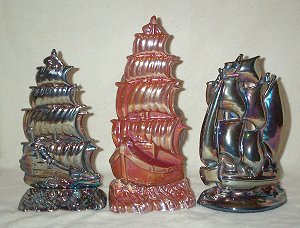 These three smaller galleons give a good idea of the range of variations on popular images that was available |
The next important development came right at the start of 2005 when we were emailed by Julia Osborne, who told us that her parents had a large collection of vitreous enamel fireside furniture; and she very kindly sent us photos. This collection does contain some of the same pieces as we have already seen but a lot of others which we have not. And they all appear to be in very good condition - so that Julia has been able to read some markings stamped in to the backs, which may give good leads as to who made which pieces. Not all of the registered design numbers are guaranteed to be accurate Here are the photos of some of the pieces. |
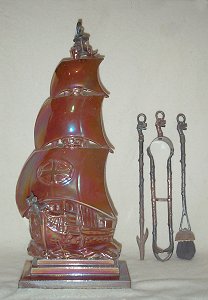 |
This is a large and magnificent galleon. There is a free winging lap at the top of the mast. The dragon like figurehead is in a different colour of enamel; and the same dragon heads in the same colour appear on the tools - indicating that they must be the originals, specially made to go with this piece. On the back there are the words "Made in England RD821369" then CC or CO. That registered design number is for 1937. |
| Two of these knights are
familiar but the large and splendid one on the right is not.
This example of the knight with the feathers in his hat is marked "Nestor Reg No 879047", which is for a date after 1950. |
|
On the right is Mr Pickwick, another very popular figure in all sort of domestic arts. He has & "Made in England" on his back. | 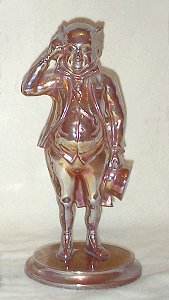 |
 |
|  | The Dutch boy and girl are also popular art figures. |
| And at one's fireside one expects one's pet cat and dog. |
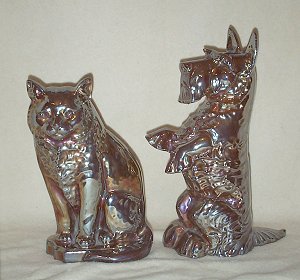
| All this was just about sorted out when we noticed that Kath
Kiely had a knight which stood on a different base: All the other knights in this style stand on a stepped base, though there do seem to be two varieties of that base. Kath's knight is on a knobbly base which must represent some sort of ground. Knights usually fought on open grass land but Tennyson wrote a line about a knight (in, I think, the Idylls of the King: "the bare, black rocks clanged round him as he strode" which is much more dramatic than dancing on the lawn. So let them be rocks. |
Conclusions so far
We know that Bilston Foundries made a cast iron and enamelled continuous burning fire called The Bilston Knight. These were first made in or before 1932.
They, or a rival company, made a fire with a portcullis design with figures of knights at each end.
The companion sets in the form of a knight were made to suit these grates and to meet the interest in all things medieval. Knights were certainy made by Cannon (who made the caped knights); and by Bilston Foundries; and by Fryers.
These sets were enamelled by Jordans, Hurst Hill Enamels and possibly by other companies as well. They come in a variety of colours and some of them had two or three colours on them.
The companion sets, by association with the fire and because of their design, became known as Bilston Knights, at least locally.
One or more companies, including Cannon, and presumably including Bilston Foundries, made other items of use or ornament, out of enamelled cast iron, mostly, but not exclusively, intended for the hearth.
The fire was made from at least 1932. The companion sets and other hearth furniture were probably originally made from about the same time. The knights were still being made at least as late as 1965. Probably they, like a lot of other things, went out of fashion in the swinging sixties and production stopped.
In the metal bashing industries of the Black Country some companies with foundries only made and sold their own products. Others only made to order for other companies. Others would do both. Companies who did enamelling (or applied other finishes) would normally do that work for other companies. It seems likely that these fireside pieces were cast by one company (for example, Cannon), enamelled for them by another company (for example, Jordans) and then marketed by the first company. But it is possible that one company designed them, had them cast (say by Fryer's, Shaw's or some other foundry) and then had them enamelled by other companies, and then marketed them. It is also possible that some of these items were made partly or entirely outside the area.
An archaeologist, confronted with the two grates and a companion set, all undated, would try to arrange them as a sequence. On this basis it is tempting to see the Bilston Knight grate as coming first. It is possible that, when it was made, the posts at each end of the front suggested a human figure. So, in accordance with the general half-timbered, medieval, cottage feel of the grate it was decided to turn the side posts into knights. That resulted in the second grate. When it was decided to produce companion sets which matched the grates, a knight would then be the obvious choice. On the other hand the sequence could be read as being that the grate which incorporated a knight at each end was the one that came first and originally suggested the name Bilston Knight. When the continuous burning fire of the 1932 advert was made it retained the name but not the knights, which were, so to speak, taken off, made larger and turned into a matching companion set.
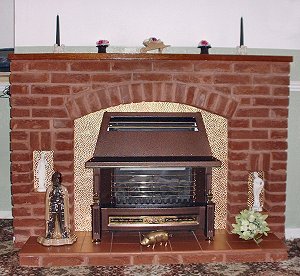
The companion sets were made for use and decoration. To-day few people would use them. But they still make nice ornaments, even in a modern setting.
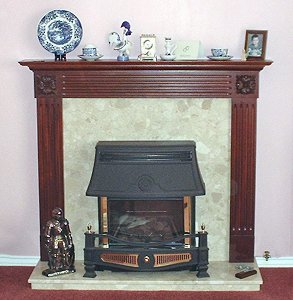
We started on our quest thinking we knew about Bilston Knights. We now know more and, as a result, we know better and are less certain. So we still need more information. This might come from people's own stories or stories of their relatives; and from written sources such as adverts or trade catalogues; and from finding and inspecting more examples.
with thanks to all those mentioned; and to the Express and Star and the Bugle for giving publicity to the quest; and to Angie Johnson for patiently scouring antique shops and markets.
Click here for page 5 of The Bilston Knights click here to go back to page 1 of the Bilston Knights click here to return to the Industry front page